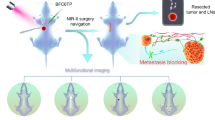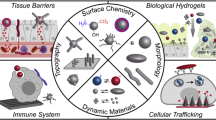Abstract
Purpose
Molecular optical imaging using monoclonal antibodies is slow with low tumour to background ratio. We used anti-HER2 VHHs conjugated to IRDye 800CW to investigate their potential as probes for rapid optical molecular imaging of HER2-positive tumours by the determination of tumour accumulation and tumour to background levels.
Methods
Three anti-HER2 VHHs (11A4, 18C3, 22G12) were selected with phage display and produced in Escherichia coli. Binding affinities of these probes to SKBR3 cells were determined before and after site-specific conjugation to IRDye 800CW. To determine the potential of VHH-IR as imaging probes, serial optical imaging studies were carried out using human SKBR3 and human MDA-MB-231 xenograft breast cancer models. Performance of the anti-HER2 VHH-IR was compared to that of trastuzumab-IR and a non-HER2-specific VHH-IR. Image-guided surgery was performed during which SKBR3 tumour was removed under the guidance of the VHH-IR signal.
Results
Site-specific conjugation of IRDye 800CW to three anti-HER2 VHHs preserved high affinity binding with the following dissociation constants (KD): 11A4 1.9 ± 0.03, 18C3 14.3 ± 1.8 and 22G12 3.2 ± 0.5 nM. Based upon different criteria such as binding, production yield and tumour accumulation, 11A4 was selected for further studies. Comparison of 11A4-IR with trastuzumab-IR showed ∼20 times faster tumour accumulation of the anti-HER2 VHH, with a much higher contrast between tumour and background tissue (11A4-IR 2.5 ± 0.3, trastuzumab-IR 1.4 ± 0.4, 4 h post-injection). 11A4-IR was demonstrated to be a useful tool in image-guided surgery.
Conclusion
VHH-IR led to a much faster tumour accumulation with high tumour to background ratios as compared to trastuzumab-IR allowing same-day imaging for clinical investigation as well as image-guided surgery.






Similar content being viewed by others
References
Capala J, Bouchelouche K. Molecular imaging of HER2-positive breast cancer: a step toward an individualized ‘image and treat’ strategy. Curr Opin Oncol 2010;22:559–66.
Ross JS, Fletcher JA. The HER-2/neu oncogene in breast cancer: prognostic factor, predictive factor, and target for therapy. Stem Cells 1998;16:413–28.
Andreopoulou E, Hortobagyi GN. Prognostic factors in metastatic breast cancer: successes and challenges toward individualized therapy. J Clin Oncol 2008;26:3660–2.
Allison M. The HER2 testing conundrum. Nat Biotechnol 2010;28:117–9.
Moelans CB, de Weger RA, Van der Wall E, van Diest PJ. Current technologies for HER2 testing in breast cancer. Crit Rev Oncol Hematol 2011;80:380–92.
Cottu PH, Asselah J, Lae M, Pierga JY, Diéras V, Mignot L, et al. Intratumoral heterogeneity of HER2/neu expression and its consequences for the management of advanced breast cancer. Ann Oncol 2008;19:595–7.
Wu J, Halushka MK, Argani P. Intratumoral heterogeneity of HER-2 gene amplification and protein overexpression in breast cancer. Hum Pathol 2010;41:914–7.
Lindström LS, Karlsson E, Wilking UM, Johansson U, Hartman J, Lidbrink EK, et al. Clinically used breast cancer markers such as estrogen receptor, progesterone receptor, and human epidermal growth factor receptor 2 are unstable throughout tumor progression. J Clin Oncol 2012;30:2601–8.
Sevick-Muraca EM. Translation of near-infrared fluorescence imaging technologies: emerging clinical applications. Annu Rev Med 2012;63:217–31.
Kovar JL, Simpson MA, Schutz-Geschwender A, Olive DM. A systematic approach to the development of fluorescent contrast agents for optical imaging of mouse cancer models. Anal Biochem 2007;367:1–12.
Massoud TF, Gambhir SS. Molecular imaging in living subjects: seeing fundamental biological processes in a new light. Genes Dev 2003;17:545–80.
Baum RP, Prasad V, Müller D, Schuchardt C, Orlova A, Wennborg A, et al. Molecular imaging of HER2-expressing malignant tumors in breast cancer patients using synthetic 111In- or 68Ga-labeled affibody molecules. J Nucl Med 2010;51:892–7.
Holland JP, Normand G, Ruggiero A, Lewis JS, Grimm J. Intraoperative imaging of positron emission tomographic radiotracers using Cerenkov luminescence emissions. Mol Imaging 2011;10:177–86.
van Dam GM, Themelis G, Crane LM, Harlaar NJ, Pleijhuis RG, Kelder W, et al. Intraoperative tumor-specific fluorescence imaging in ovarian cancer by folate receptor-α targeting: first in-human results. Nat Med 2011;17:1315–9.
van Terwisscha Scheltinga AG, van Dam GM, Nagengast WB, Ntziachristos V, Hollema H, Herek JL, et al. Intraoperative near-infrared fluorescence tumor imaging with vascular endothelial growth factor and human epidermal growth factor receptor 2 targeting antibodies. J Nucl Med 2011;52:1778–85.
Oliveira S, van Dongen GA, Stigter-van Walsum M, Roovers RC, Stam JC, Mali W, et al. Rapid visualization of human tumor xenografts through optical imaging with a near-infrared fluorescent anti-epidermal growth factor receptor nanobody. Mol Imaging 2011;2:1–14.
Huang L, Gainkam LO, Caveliers V, Vanhove C, Keyaerts M, De Baetselier P, et al. SPECT imaging with 99mTc-labeled EGFR-specific nanobody for in vivo monitoring of EGFR expression. Mol Imaging Biol 2008;10:167–75.
Mould DR, Sweeney KR. The pharmacokinetics and pharmacodynamics of monoclonal antibodies—mechanistic modeling applied to drug development. Curr Opin Drug Discov Devel 2007;10:84–96.
Roovers RC, Laeremans T, Huang L, De Taeye S, Verkleij AJ, Revets H, et al. Efficient inhibition of EGFR signaling and of tumour growth by antagonistic anti-EFGR nanobodies. Cancer Immunol Immunother 2007;56:303–17.
Belsches-Jablonski AP, Biscardi JS, Peavy DR, Tice DA, Romney DA, Parsons SJ. Src family kinases and HER2 interactions in human breast cancer cell growth and survival. Oncogene 2001;20:1465–75.
Oliveira S, Cohen R, Stigter-van Walsum M, van Dongen GA, Elias SG, van Diest PJ, et al. A novel method to quantify IRDye800CW fluorescent antibody probes ex vivo in tissue distribution studies. EJNMMI Res 2012;2:50.
Schmidt MM, Wittrup KD. A modeling analysis of the effects of molecular size and binding affinity on tumor targeting. Mol Cancer Ther 2009;8:2861–71.
Vaneycken I, Devoogdt N, Van Gassen N, Vincke C, Xavier C, Wernery U, et al. Preclinical screening of anti-HER2 nanobodies for molecular imaging of breast cancer. FASEB J 2011;25:2433–46.
Mume E, Orlova A, Larsson B, Nilsson AS, Nilsson FY, Sjöberg S, et al. Evaluation of ((4-hydroxyphenyl)ethyl)maleimide for site-specific radiobromination of anti-HER2 affibody. Bioconjug Chem 2005;16:1547–55.
Lee SB, Hassan M, Fisher R, Chertov O, Chernomordik V, Kramer-Marek G, et al. Affibody molecules for in vivo characterization of HER2-positive tumors by near-infrared imaging. Clin Cancer Res 2008;14:3840–9.
Lammers T, Kiessling F, Hennink WE, Storm G. Drug targeting to tumors: principles, pitfalls and (pre-) clinical progress. J Control Release 2012;161:175–87.
Abbas N, Bruland ØS, Brevik EM, Dahle J. Preclinical evaluation of 227Th-labeled and 177Lu-labeled trastuzumab in mice with HER-2-positive ovarian cancer xenografts. Nucl Med Commun 2012;33:838–47.
Behr TM, Goldenberg DM, Becker W. Reducing the renal uptake of radiolabeled antibody fragments and peptides for diagnosis and therapy: present status, future prospects and limitations. Eur J Nucl Med 1998;25:201–12.
Gainkam LO, Caveliers V, Devoogdt N, Vanhove C, Xavier C, Boerman O, et al. Localization, mechanism and reduction of renal retention of technetium-99m labeled epidermal growth factor receptor-specific nanobody in mice. Contrast Media Mol Imaging 2011;6:85–92.
Acknowledgments
We would like to thank Mies Steenbergen, Anton Terwisscha van Scheltinga and Titia Lamberts for technical support. We thank Prof. Dr. Paul van Diest and Prof. Dr. Willem Mali for interesting discussions. We thank QVQ BV for providing pQVQ72 vector. This research was supported by the Center for Translational Molecular Medicine (MAMMOTH project).
Author information
Authors and Affiliations
Corresponding author
Electronic supplementary material
Rights and permissions
About this article
Cite this article
Kijanka, M., Warnders, FJ., El Khattabi, M. et al. Rapid optical imaging of human breast tumour xenografts using anti-HER2 VHHs site-directly conjugated to IRDye 800CW for image-guided surgery. Eur J Nucl Med Mol Imaging 40, 1718–1729 (2013). https://doi.org/10.1007/s00259-013-2471-2
Received:
Accepted:
Published:
Issue Date:
DOI: https://doi.org/10.1007/s00259-013-2471-2




